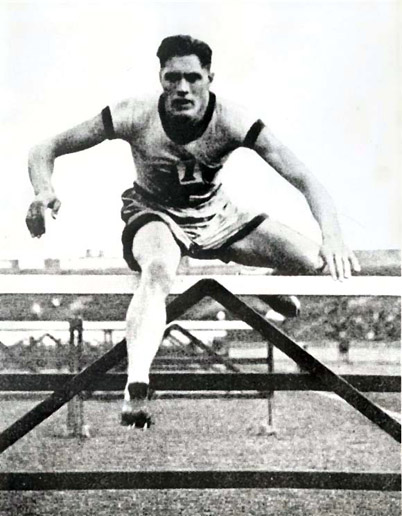Hall of Famer
Earl 'Tommy' Thomson
Inducted in 1955
Member Details
Career Highlights
AAU champion - high hurdles
IC4A champion - high hurdles
Olympic Games, gold medal - 110m hurdles
IC4A champion - low hurdles
NCAA champion - high hurdles
AAU champion - low hurdles

Story
He was Canada's post-First World War hurdling star, which was no small leap considering he had to travel all the way from California to bring home a Canadian gold medal from Belgium. Earl 'Tommy' Thomson was born on a farm near Birch Hills, Saskatchewan, about 35 kilometres from Prince Albert. In 1903, the family moved to California, eventually settling in Long Beach. While at Long Beach Poly High School, Thomson played baseball and football as well as running track.
In the spring of 1916, he enrolled in the University of Southern California. While at USC, Thomson set a world record in the 110yd. high hurdles of 14.8 seconds,becoming the first person to break 15 seconds,only to see teammate Bob Simpson run 14.6 seconds a week later. That fall, Thomson transferred to Dartmouth College in New Hampshire, but his track career was put on hold by the hostilities in Europe. In 1917, he enlisted as an observer trainee in the Royal Flying Corps and was stationed initially in Toronto. While training at the RAF base in Beamsville, Ontario, he made the base track team that travelled to Toronto for an RAF meet in 1918. Thomson was the star of the meet, taking five firsts and one second. He was commissioned too late to see service overseas and returned to Dartmouth to finish his studies and resume his track career.
Thomson's standing as one of North America's great hurdles specialists was solidified in the four years after the end of the First World War. In 1919, he set a new world record for the high hurdles of 14.4 seconds at the IC4A championships in Philadelphia, a title that he defended in both 1920 and 1921, also winning the low hurdles in the latter year. In 1921, the NCAA held its first U.S. national intercollegiate championships at Soldier Field in Chicago and Thomson won the high hurdles by equalling his world record time. Thomson was also three times U.S. AAU national champion in the high hurdles, capping his career with a victory in 1922 in that event. But it is for his appearance at the 1920 Olympics that Thomson is best remembered by Canadians.
Eager to compete against the world's best, he informed American AAU authorities, who had expressed an interest in having him join the U.S. team travelling to Antwerp, that he was still a Canadian citizen. He went to Montreal and qualified for the Canadian team in both the broad jump and the high hurdles. At the Olympics, it was the two Americans who were his greatest competition in the 110m hurdles. The three hurdlers were even through 50 metres before Thomson surged ahead to win the gold medal in an Olympic record time of 14.8 seconds.
Thomson remained at Dartmouth for a year as assistant track coach while finishing his studies. Coaching, however, was to become his career. He spent a year as the track coach at the University of West Virginia and four years as the assistant coach at Yale before, in 1927, accepting the position as head coach for the track team at the U.S. Naval Academy in Annapolis, Maryland. In 1945, his men's team won the NCAA outdoor championship. Thomson would remain Navy's track coach for 36 years, retiring in 1963. He was not done inspiring young athletes, however. Billy Mills, the Native American long distance runner who won the 10,000 metres gold medal at the 1964 Tokyo Olympics, credited Thomson in helping him believe in his ability to achieve lofty goals.






